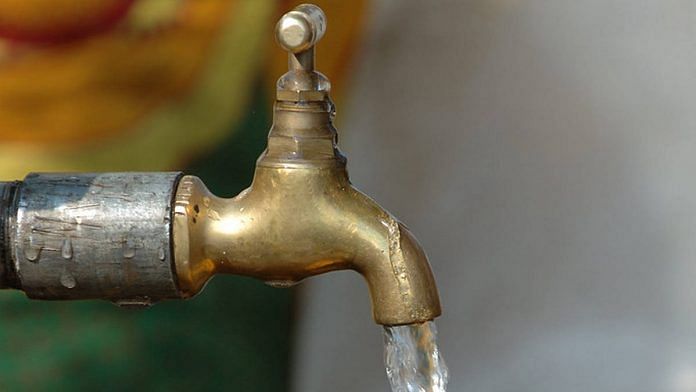New Delhi: The Narendra Modi government has constituted a four-member Group of Ministers (GoM) headed by Union Minister for Home Affairs Amit Shah to fine-tune modalities for the ‘Har Ghar Nal Se Jal’ (tap water in every home) scheme. The GoM will finalise the user fee to be charged for providing potable piped water to 18 lakh rural households under the programme, officials familiar with the matter told ThePrint.
The other members of the GoM are Jal Shakti Minister Gajendra Singh Shekhawat, Agriculture Minister Narendra Singh Tomar and Minister of State (Independent Charge) for Housing and Urban Affairs Hardeep Singh Puri.
The GoM was constituted last month, soon after the cabinet approved the Jal Jeevan Mission, which envisages providing up to 55 lpcd (litre per capita per day) water to every rural household by 2024.
“It was following cabinet approval that Prime Minister Narendra Modi announced the allocation of Rs 3.35 lakh crore for the Jal Jeevan Mission in his Independence Day address,” said an official who did not want to be identified.
Also read: Modi govt’s flagship water scheme Jal Jeevan Mission gets Rs 3.35 lakh crore
Why a user fee?
The informal GoM has already met once to discuss the modalities, and its broad mandate is to look into the framework of the programme, including working out the user fee.
“A user fee has to be levied for operating and maintaining the system. The GoM, based on its interactions with stakeholders, will decide the fee,” said the official. “It will be very nominal, in the range of Rs 30 to Rs 50 per household.”
The Jal Shakti ministry, which is piloting the Nal Se Jal programme, is closely looking at similar piped water supply schemes running in states like Bihar, Telangana and Sikkim before finalising the user-fee. In Bihar, for instance, a monthly user fee of Rs 30 is levied for providing piped water supply to below-poverty-line households, while the rest are charged Rs 60.
A second official said the allocation of Rs 3.35 lakh crore for the Jal Jeevan Mission — Nal Se Jal scheme is part of this — will be primarily used to put in place the physical infrastructure required to take piped water supply to the approximately 18 lakh rural households.
Of the Rs 3.35 lakh crore, the central government will contribute half, while states will bear the remaining cost. For union territories, the Centre will give 100 per cent funding. For the Northeast, the central share will be 90 per cent while states will foot the rest.
The scheme is an upgraded version of the National Rural Drinking Water Programme launched in 2009. That programme aimed to provide drinking water to rural areas by 2030 at an estimated cost of Rs 6 lakh crore.
Also read: Crisis no one is talking about: India’s water stress nearing Day Zero, when taps run dry
Innovative model
To encourage community participation, the Jal Shakti ministry has worked out an innovative model where 10 per cent of the capital cost of a project will be borne by the community, either in cash or in the form of labour.
Once the project is completed, the ownership of the project will be given to the villagers, along with the money they have contributed. “The money will be reimbursed to the community, which they can use for operation and maintenance of the project,” the second official quoted above said.
For instance, if the cost of a project is Rs 20 lakh, the community will contribute Rs 2 lakh. “Once the project is complete, the money will be returned to the community in the form of a fixed deposit. The community can use it for running and maintaining the project,” the official added.
Also read: How the business of water scarcity can be tackled in India




Vote for Kejriwal and get free Bisleri piped water for free for lifetime
3.35 lac crores for 18 lac households, say a population of one crore people. That works out to a capital spend of 3.35 lacs per person, clearly way over the top. And one crore people do not India make. Perhaps the figures need to be tidied up. In any case, the government does not seem inclined to charge anything resembling an economic price, just what has knocked the stuffing out of the economics of the discoms that give farmers power almost free of cost.